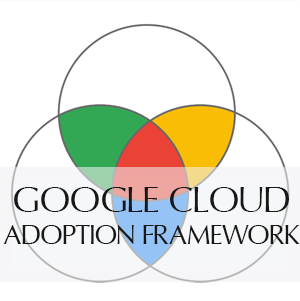The Google Cloud Adoption Framework
Leveraging leadership and people management best practices like re:Work, Site Reliability Engineering and BeyondCorp, Google developed a framework for adopting the cloud, know as The Google Cloud Adoption Framework. This framework works with people, processes and technology, allowing you to see where you are now in your cloud adoption journey, and get your where you want to be. You can use the framework to make an assessment of your readiness for the cloud and what you will need to development to get there.
For Google’s official look at the Cloud Adoption Framework, with a deeper dive on each of the components, see their whitepaper here: https://cloud.google.com/adoption-framework
Four Themes of Cloud Adoption
To bring your organization into the cloud, there are four themes you will need to excel in, regardless of your business objectives.
- Learn – The value and scale of your learning programs that you have in place to enhance to skillset of your technical teams. It also refers to your ability to supplement your technical teams with the right partners.
- Lead – The degree to which your technical teams are supported from leadership to migrate to the cloud. Additionally, we need to consider how cross-functional, collaborative, and self-motivated these teams are.
- Scale – The degree to which you will use cloud-native services which will reduce operational overhead and automate manual processes and polices.
- Secure– Your capacity to protect your cloud services from unauthorized access using a multilayered, identity-centric security model.
Three Phases of Each Theme
Each of the themes above will fall into one of these three phases.
| Phase | Description |
| Tactical | You have individual workloads in place but no solid plan bringing them all together with a strategy that builds out towards the future. |
| Strategic | You have a broader vision that brings together the individual workloads which are designed and developed with a concern for future needs and scale. |
| Transformational | With your cloud operations now functioning smoothly, you are integrating data and insights learned from working now in the cloud. |
The Cloud Maturity Scale
Once you have assessed what phase each theme falls into, you can begin to paint a picture of your cloud maturity. We can combine them as follows:
| Learn | Lead | Scale | Secure | |
| Tactical | Self-taught with 3rd party reliance. | Teams by function with a central project manager | Chance is slow and risky with operations still heavy | Fear of public internet, but trust in private network |
| Strategic | Organized training with assistance from 3rd parties. | New cross-function cloud team | Templates are allowing for reliable governance without manual review | Central identity with a hybrid network |
| Transformational | Peer learning and sharing. | Cross-function featured teams and greater autonomy | All change is constant, low risk, and quickly fixed | Trust only the right people, devices and services |
Fine-tuning Your Direction with Epics
Once you have found your position on the maturity map above, you can start to plan a path forward. The scope and structure of the program you will use for cloud adoption can be broken into workstreams, which Google refers to as epics. Epics are designed to not overlap one another, are aligned to manageable groups of stakeholders and can be further broken down into induvial user stories.

In summary, these are the three components of the framework Google Cloud uses to help you get to the cloud:
- Three Maturity Phases applied to the
- Four Adoption Themes
- Epics



Leave a Reply
Want to join the discussion?Feel free to contribute!